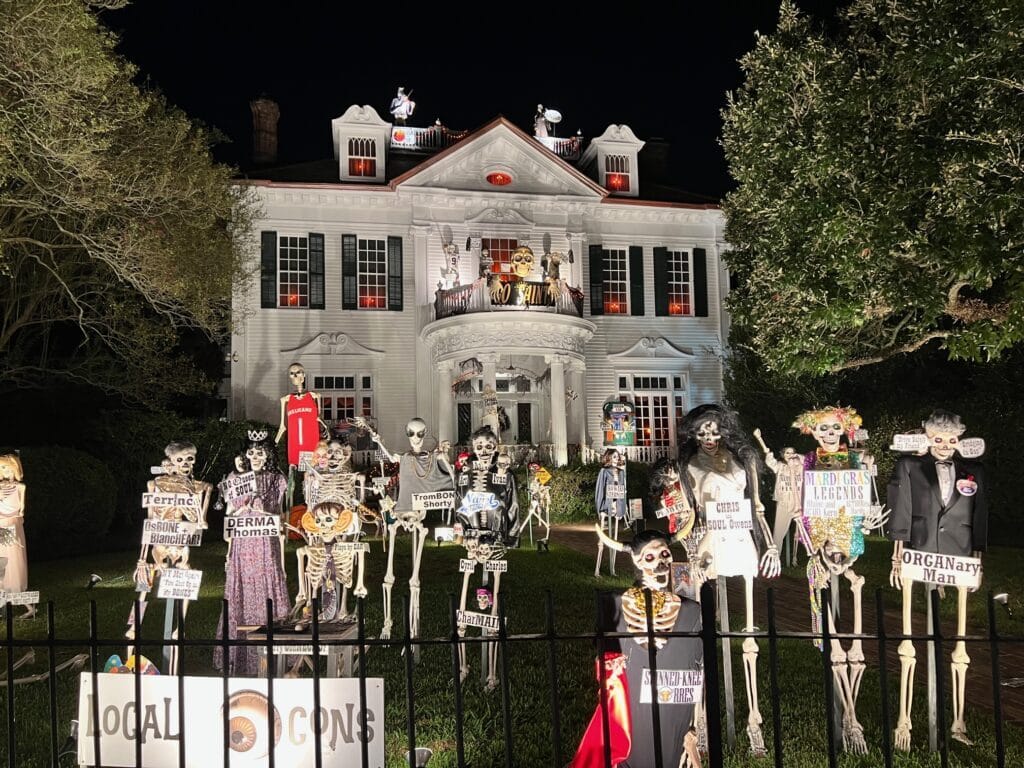
Amazing Halloween decorations seen in New Orleans. Photo by Broke-Ass Stuart
BY JAMES CONRAD
Christmas may be the most wonderful time of the year for many people. However, an appreciable swath of the population say Halloween is where it’s at, especially as it gives opportunities for ingenious souls to indulge their creative passions, particularly when it comes to decorating.
With that in mind, and not to be a buzzkill, Halloween decorations should be set out in such a way that they pose no harm to trick-or-treaters, partygoers or local wildlife, neither attract nor encourage vandals, and create no unwanted distraction for passing motorists and emergency personnel, or otherwise attract unnecessary attention from the latter.
While autumnal wreaths and harvest corn offer a nice touch for the front door, it is necessary to hang them in such a way that they do not obstruct the view of peephole and ring cameras.
Large prop-up displays near doors and entranceways can also provide hiding places for people who harbor nefarious motives.
Your entranceway should also be sufficiently lit to avoid tripping hazards and to discourage would-be vandals from doing their thing and getting away unseen. However, using a strobe light in your display could create a dangerous distraction for passing drivers and may also pose a hazard to people who suffer from epilepsy.
Local Journalism for Working stiffs
We write for the poets, busboys, and bartenders. We cover workers, not ‘tech’, not the shiny ‘forbes 100 bullshit’. We write about the business on your corner and the beer in your hand. Join the Bay's best newsletter.
If any part of your outdoor display requires electricity, be sure to use a U/L-listed extension cord specifically designed for outdoor use – these are thicker, have more dense insulation and as a result are more durable.
Electrical outlets equipped with ground fault circuit interrupters, or GFCIs are recommended for outdoor use, as they will cut power to the circuit in the event of an electrical short. Do not plug too many devices into one outlet, either, as the excess electrical current will generate heat that can cause a fire.
Be sure that these cords are kept out of the way of traffic and away from water. If necessary, use insulated staples to securely fasten a cord in place.
Safely discard and replace any extension cord that shows cracking, fraying or bare wires, as this poses the danger of an electrical fire.
Using a timed switch on your display will not only save energy but will also further reduce the risk of fire and other electrical accidents.

Photo by Jennifer C. on Flickr.
Do not erect your displays near the road – keep them close to your house instead. This way, your display is less likely to be vandalized, create a distraction for passing motorists or attract unwanted attention from local authorities, thereby constraining resources at a time when they are needed most due to increased risk of pedestrian accidents.
In 2021, motorists in New York State’s Hudson Valley were startled by a display of a realistic looking werewolf behind a tree. That same year in Lily, Pennsylvania, a display consisting of the Grim Reaper standing atop a wrecked car appeared authentic enough that first responders were called to the vicinity. Ultimately, the owners of the property hung a sign advising people not to call 911, as no car accident had actually taken place.
Artificial spiderweb, commonly made of cotton or polyester, may look festively spooky. Unfortunately, it can snare and kill ecosystemically important animals active during autumn, such as bees, hummingbirds, owls and other birds and may also pose a problem to rambunctious children and outdoor pets like cats and small dogs.

Look how spooky real spiderwebs can be. Photo by the author.
Instead, if you have the golden opportunity to decorate a space that has a garden, you can attract spiders by setting down a loose layer of mulch, such as grass clippings and/or dead leaves, between the plants and rows, as this will provide the moist conditions that spiders prefer and attract the insects that they eat. Tall plants also attract spiders, as they provide a natural frame on which to spin a web and produce moisture through transpiration, in which water evaporates through the leaves. If you don’t have a garden, place the mulch between your display pieces so that the spiders will build their webs there.
Once the spider has built its web, you can illuminate it with a strategically placed LED tea light. In turn, this will lead more insects to the spider, as they will be enticed by the glow. More food for the spider will result in more spiders, in turn resulting in more webs for Halloween.
Otherwise, artificial spiderwebs should be kept inside and hung as tightly as possible against walls and ceilings, so that party guests, children and pets don’t get tangled up or tripped.
The post How to Decorate Your Home For Halloween…Safely appeared first on Broke-Ass Stuart's Website.










